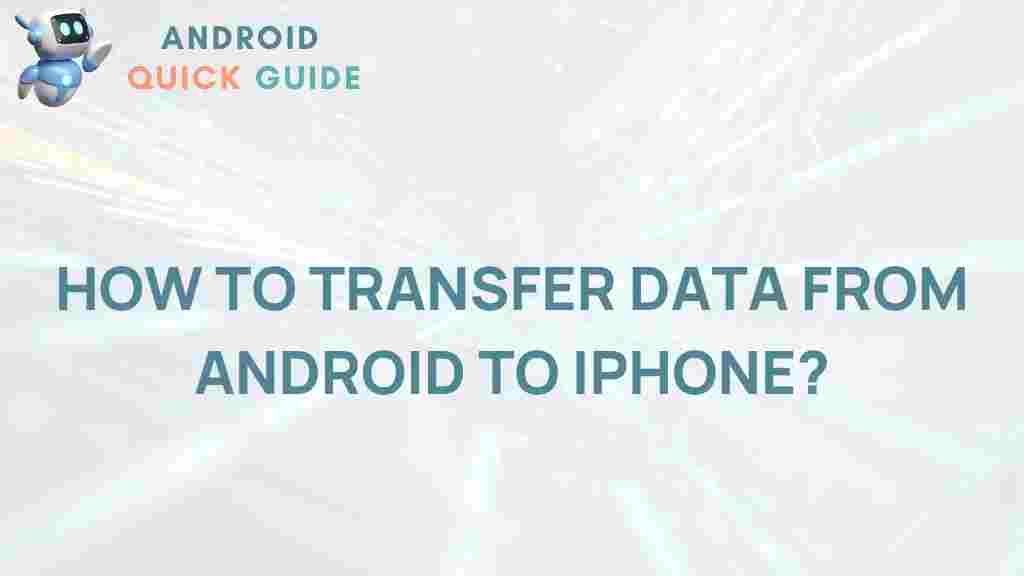Data Transfer: Unveiling the Secrets of Moving Data from Android to iPhone
Switching from an Android device to an iPhone can be an exciting experience, but it often raises concerns about transferring essential data seamlessly. Fortunately, there are reliable methods for moving files, contacts, photos, and even apps from your Android device to your new iPhone. This guide will take you through each step of the data transfer process, covering everything you need to know to make the transition as smooth as possible.
Why Data Transfer Matters When Switching Devices
For many users, smartphones hold a treasure trove of essential information, from photos and videos to important contacts and calendar events. When moving from Android to iPhone, it’s crucial to ensure that none of this valuable data is lost. Proper data transfer can preserve your memories, business contacts, and personal information, ensuring a seamless transition between platforms.
How to Transfer Data from Android to iPhone
Transferring data from an Android to an iPhone may seem daunting, but Apple provides several tools and options to help. Here’s a look at the best ways to ensure a smooth data transfer between these two platforms.
Using the “Move to iOS” App
Apple’s Move to iOS app is a dedicated solution for Android users looking to switch to iPhone. This app, available on the Google Play Store, simplifies data transfer and is generally one of the fastest methods. Here’s a step-by-step guide:
- Step 1: Begin by downloading the Move to iOS app on your Android device.
- Step 2: Set up your iPhone. During setup, select the “Move Data from Android” option when you reach the “Apps & Data” screen.
- Step 3: Open the Move to iOS app on your Android device and tap “Continue.”
- Step 4: You’ll see a unique code displayed on your iPhone. Enter this code on your Android device.
- Step 5: Choose the content you want to transfer: contacts, message history, photos, videos, web bookmarks, mail accounts, and calendars.
- Step 6: Tap “Next” to initiate the transfer. The data will move over to your iPhone wirelessly.
The Move to iOS app transfers most essential data, but some elements, such as apps or certain types of media, may need to be downloaded again manually on your iPhone.
Transferring Photos and Videos Separately
If you have a significant number of photos and videos, it may be faster and more efficient to transfer them separately. Here are two effective methods:
Using Google Photos
- Step 1: On your Android device, open the Google Photos app and ensure that all photos and videos are backed up.
- Step 2: Download and open the Google Photos app on your iPhone, sign in with the same account, and you’ll have immediate access to your photos and videos.
Using a Computer
- Step 1: Connect your Android device to your computer and transfer photos and videos to a folder.
- Step 2: Connect your iPhone to the computer, open iTunes (or Finder on macOS Catalina and later), and use the “Photos” tab to sync your files.
Moving Contacts from Android to iPhone
Ensuring your contacts make it to your new device is crucial for continuity. You can either transfer them using Google Account Sync or by exporting and importing manually:
Google Account Sync
- Step 1: Ensure your contacts are synced with your Google account on your Android device.
- Step 2: On your iPhone, go to Settings > Mail > Accounts > Add Account and select Google.
- Step 3: Sign in and ensure “Contacts” sync is enabled.
Export and Import Contacts Manually
- Step 1: On your Android device, export your contacts as a .vcf file.
- Step 2: Email this file to yourself and open it on your iPhone. This will import the contacts directly into your iPhone’s address book.
Syncing Calendar and Email Accounts
Keeping your calendar and emails synced is equally important. To do this, simply add your Google account to your iPhone under the “Mail” settings. Ensure that both “Calendars” and “Mail” are enabled. If you prefer using iCloud, you can also manually transfer events to the iCloud Calendar.
Troubleshooting Common Data Transfer Issues
While these methods are generally reliable, you may encounter a few data transfer issues. Here’s a look at common problems and how to address them:
Move to iOS Transfer Stuck
If the Move to iOS app gets stuck or freezes, try the following:
- Ensure both devices are connected to a stable Wi-Fi network.
- Restart both devices and reattempt the transfer.
- Make sure both devices have enough storage space for the transfer.
For more information, you can check out Apple’s official troubleshooting guide for additional support.
Data Not Transferring Completely
Sometimes, certain files or data types don’t make it to the iPhone. If this happens:
- Ensure that the data type is supported by the Move to iOS app.
- Check if the data, like apps or certain media files, may require a separate transfer process.
Using a manual transfer method can also be a reliable backup if an automatic transfer doesn’t capture everything.
Conclusion: Making Your Data Transfer Effortless
Switching from Android to iPhone doesn’t have to mean leaving your data behind. By using tools like the Move to iOS app, Google Photos, and Google Sync, you can confidently move contacts, photos, videos, and other essential files to your new device. Remember, for any issues, try a manual approach, or consult Apple’s resources for additional support.
Ready to make the leap? Check out more tips and tutorials on seamless device transitions by visiting our resource center for additional insights and best practices!
This article is in the category Guides & Tutorials and created by AndroidQuickGuide Team
